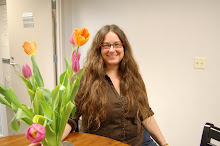
Suzuki training with sticks
This is a brief overview -- a glimpse, not a full description.
Suzuki Training is a physical theatre training created by theatre director, Tadashi Suzuki. From the SITI, Saratoga International Theatre Institute site whose artistic director, Anne Bogart, is a long-time colleague of Tadashi Suzuki's:
SUZUKI METHODSlowtens are essentially a form of radiant ultra-slow walking. You only do these after you are dripping with sweat from an hour of hard physical movement. Like classical ballet floorwork, which is only begun after an hour of barre, slowtens are only done after the body is supple and hot from an hour of Walking, Marching, and Statues.
Developed by internationally acclaimed director, Tadashi Suzuki and the Suzuki Company of Toga, the Suzuki Actor Training Method's principal concern is with restoring the wholeness of the human body to the theatrical context and uncovering the actor's innate expressive abilities. A rigorous physical discipline drawn from such diverse influences as ballet, traditional Japanese and Greek theater and martial arts, the training seeks to heighten the actor's emotional and physical power and commitment to each moment on the stage. Attention is on the lower body and a vocabulary of footwork, sharpening the actor's breath control and concentration.
When you see people doing slowtens, they look like driftwood moving. Their glances are fixed, their gaze luminous, their bodies caught in windswept positions. They seem to not so much wade through space, as drift through it. They move like underwater statues. You want to, and can, examine the actors very closely when they are in such a state. They are like a suspended moment of a person, transfixing.

Slowtens used in performance

Robyn Hunt, my Suzuki teacher, in slowtens in The Water Station
Moving inside this form makes your thoughts as radiant and slow as the movement. You are not thinking, but slow truths arise.
Don't think, don't think, don't think. Don't know, don't know, don't know. Don't think.
One point of the training is that power for an actor arises from the earth. Connected to the earth, an actor can do anything.
Another point is to learn how to let the truth arise in each moment. Don't plan. Don't know before you get there. The truth of each moment discovered in that moment is far more wondrous and real than any forethought.
If you can learn to move this way, you can learn to live on stage, and in the world.

Performers at the end of a shakuhachi
Shakuhachis -- so-called because the song to which this part of the training is taught is played on the shakuhachi bamboo flute -- are the same ultra-slow-mo, moment-to-moment movement, but these begin with the actor lying collapsed on the floor.
When the music starts, the actor 1) slowly oozes upward to standing, 2) drifts to the front edge of the stage, 3) drifts back, and 4) sinks infinitesimally slowly all the way back to the earth. Extremely difficult and exacting.
As Roberta Carerri of the Odin says and Robyn Hunt, my Suzuki teacher, would agree, "A fall of even a millimetre is a fall."

1 comment:
so so true. i thought today about your writing, how important it is, and how woderful it is to be able to dip into your words when the banality of the daily world collapses my shoulders. Slowtens are also like watermill wheels that propell one's body through extended ecstasy, secretly exploding deep inside... Odin Week was magical. Thank you for your Odin posts.
Post a Comment